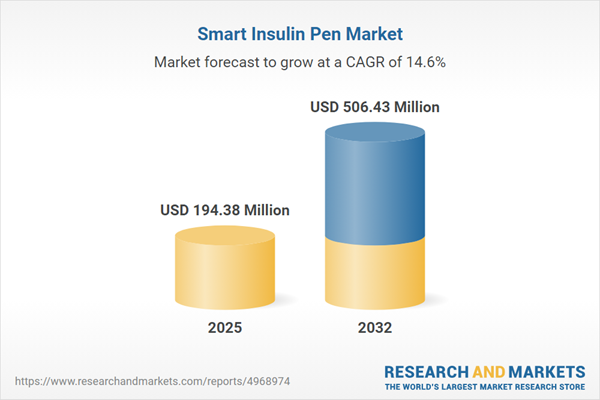Speak directly to the analyst to clarify any post sales queries you may have.
The smart insulin pen market is rapidly transforming diabetes management for healthcare organizations, aligning advanced digital health tools with evolving clinical and operational requirements. As executive leadership in healthcare steers digital transformation initiatives, integrated smart pen solutions are increasingly vital for optimizing both patient outcomes and organizational performance.
Market Snapshot: Smart Insulin Pen Market Size and Growth
In 2024, the global smart insulin pen market reached USD 169.95 million and is projected to rise to USD 194.38 million by 2025, with long-term forecasts extending to USD 506.43 million by 2032. The sector records a CAGR of 14.62%, underscoring heightened demand for digital solutions in diabetes care.
As healthcare organizations focus on interoperability and actionable analytics, integrated data channels are facilitating the shift toward more efficient, compliant, and outcomes-oriented diabetes care models.Scope & Segmentation of the Smart Insulin Pen Market
- Device Types: Disposable smart insulin pens enable streamlined infection control and align with strict safety protocols for acute settings, while reusable devices support sustainability goals and operational cost containment relevant to healthcare organizations prioritizing long-term efficiency.
- Connectivity Options: Technologies integrating Bluetooth, Wi-Fi, or cellular capabilities deliver real-time dose monitoring and optimized data flows with EHR systems, enhancing decision-making and care coordination. Non-connected options maintain relevance in workflows prioritizing privacy or operating in digital-limited environments.
- Diabetes Classification: Smart insulin pen platforms tailored to both Type 1 and Type 2 diabetes enable granular personalization of therapy across patient groups, strengthening clinician ability to align regimens to diverse population needs.
- Distribution Channels: Widespread availability through hospital pharmacies, retail locations, and vetted online portals improves procurement flexibility for organizations operating in both urban health centers and underserved communities.
- End Users: Device capabilities accommodate adults, children, and older adults, supporting improved usability, adherence, and therapy satisfaction within varied patient cohorts to help organizations achieve population health goals.
- Regions Covered: The smart insulin pen market operates across North America, Europe, Asia-Pacific, the Middle East, and Africa, allowing providers to develop adoption strategies attuned to unique regulatory requirements and local care delivery contexts.
- Key Companies: Industry leaders including B. Braun SE, Eli Lilly and Company, Sanofi S.A., Medtronic plc, Becton, Dickinson and Company, Insulet Corporation, Emperra GmbH, Pendiq GmbH, and Owen Mumford Ltd. actively refine portfolios and build strategic partnerships to address shifting healthcare needs and foster sustained device innovation.
Key Takeaways: Strategic Insights for Senior Healthcare Leaders
- Integrating smart insulin pens into care pathways enhances therapy accuracy, promotes care team coordination, and facilitates more responsive, patient-focused diabetes management frameworks.
- Automated data capture streamlines administrative burden, redeploying staff resources to core clinical services and optimizing capacity planning within organizations of all sizes.
- Strategic alliances between medtech vendors and pharmaceutical manufacturers foster robust system compatibility, supporting simplified device integration and effective deployment across complex healthcare networks.
- Continuous advancements in device usability and accessibility promote adoption by a broader range of patients, supporting improved medication adherence and continuity of care across multiple settings.
- Adaptive implementation planning enhances regulatory agility, positioning healthcare organizations to satisfy evolving compliance standards and maintain digital transformation momentum.
Tariff Impact: Navigating the U.S. 2025 Policy Shift
Forthcoming adjustments to U.S. import tariffs in 2025 have prompted manufacturers to diversify supply chain strategies and refine logistics planning. These measures help ensure ongoing product availability for providers, while counteracting increased operational costs amid changing trade scenarios.
Methodology & Data Sources
The analysis combines insights from certified diabetes educators and practicing endocrinologists with systematic reviews of clinical guidelines and scrutinized industry datasets. This approach provides actionable intelligence tailored to support executive-level planning and procurement in healthcare environments.
Why This Report Matters
- Supports evidence-driven investments by tracking adoption trends for smart insulin pen technologies and mapping their integration within advanced digital care ecosystems.
- Details how digital insulin pen solutions contribute to improved workflows, scalable operational models, and enhanced agility for organizations operating across distributed networks.
- Enables senior leaders to proactively address shifting regulatory and technical landscapes, empowering effective risk management and care continuity.
Conclusion
Armed with these insights, decision-makers can strengthen diabetes care strategies, advance cross-disciplinary collaboration, and promote operational resilience throughout rapidly changing healthcare markets.
Additional Product Information:
- Purchase of this report includes 1 year online access with quarterly updates.
- This report can be updated on request. Please contact our Customer Experience team using the Ask a Question widget on our website.
Table of Contents
3. Executive Summary
4. Market Overview
7. Cumulative Impact of Artificial Intelligence 2025
Companies Mentioned
The companies profiled in this Smart Insulin Pen market report include:- B. Braun SE
- Eli Lilly and Company
- Sanofi S.A.
- Medtronic PLC
- Becton, Dickinson and Company
- Insulet Corporation
- Emperra GmbH
- Pendiq GmbH
- Medtronic PLC
- Owen Mumford Ltd
Table Information
| Report Attribute | Details |
|---|---|
| No. of Pages | 198 |
| Published | November 2025 |
| Forecast Period | 2025 - 2032 |
| Estimated Market Value ( USD | $ 194.38 Million |
| Forecasted Market Value ( USD | $ 506.43 Million |
| Compound Annual Growth Rate | 14.6% |
| Regions Covered | Global |
| No. of Companies Mentioned | 11 |









